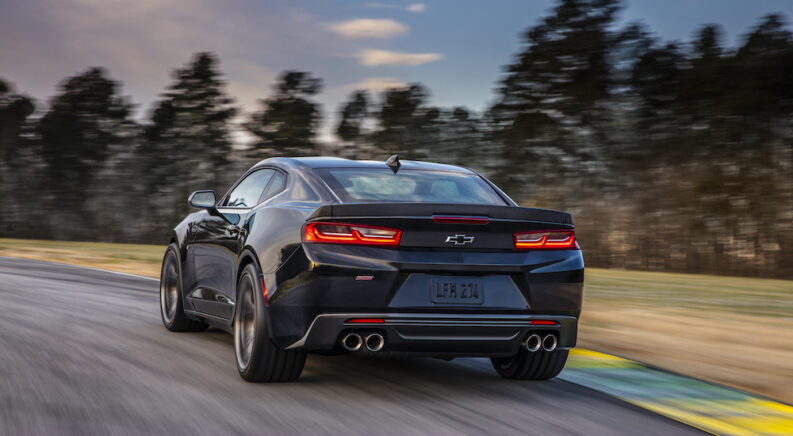Pony cars and V8 engines go together like ice cream and apple pie. If you don’t have eight cylinders under the hood of your Camaro, Mustang, or Challenger, then get ready for all the withering comments you’ll receive from enthusiasts of American muscle.
However, if you look past the preconceptions, you might just be amazed at the sort of performance that Chevy can wring out of a “feeble” V6. In fact, we might even go so far as to say that the V6 Camaro is the best affordable performance car you can find at a car dealership today.
While you certainly won’t want to take it to the drag strip against a V8 model, this entry-level model can shock traditionalists when it comes to road courses and autocross competition. It’s even a ton of fun on the open road and is a veritable bargain with brand-new examples starting at just under $30,000.
Who Needs Eight Cylinders?
The LGX V6 engine that has powered the mid-tier Camaro since 2016 is a rather remarkable piece of engineering. At 3.6L, it is the largest member of the GM High Feature family and, unlike some older V6 options, is not just an LT1 V8 with two cylinders lopped off.
Some quick math reinforces this point, showing that while the Camaro’s 6.2L V8 has 0.775L of displacement per cylinder, the 3.6L V6 only has 0.6L per cylinder. This is because the LT1 has a massive 103.25mm bore and 92mm stroke, optimizing it for low-end torque, while the LGX has a 95mm bore and 85.6mm stroke.
This difference in internal dimensions means that the V6 is a much more rev-happy engine, developing peak horsepower at 6,800 RPM and peak torque at 5,300 RPM. In contrast, the Camaro’s V8 hits peak horsepower at just 6,000 RPM and peak torque at 4,400 RPM. While that does mean you’ll need to push the LGX harder than the LT1 to get its full performance, it also means that the V6 has significantly more power per liter than the big V8.
With 335 hp and 284 lb-ft of torque, the V6 Camaro generates 99 hp and 79 lb-ft per liter of displacement. Although the LT1 has much higher total ratings at 455 hp and 455 lb-ft of torque when you consider its much larger displacement, that translates to just 73 hp and 73 lb-ft per liter. It’s not that impressive when you think about it that way. That difference in power density also translates to a difference in overall weight, with the V6 Coupe tipping the scales at just 3,411 lbs compared to 3,619 lbs for the V8 Camaro.
More Than an Engine
Sports car enthusiasts—particularly pony car enthusiasts—tend to spend an inordinate amount of time talking about engines. However, the engine is just one small part of what makes a good sports car, and focusing on the argument between V6 and V8 ignores that both versions of the Camaro share the same platform and most of the same go-fast features. While models with the V8 will, of course, be faster in a straight line, things are much closer when it comes to handling––and the V6 might just be better.
As many GM fans know, the current Camaro is built on the Alpha platform, which was originally developed for the Cadillac ATS and CTS, and this underpins the new Cadillac CT4 and CT5. This lends a level of refinement to the Camaro that you won’t usually see in an American muscle car. In many ways, it’s closer to a BMW 3 Series than a Dodge Challenger, with sharp handling that comes alive on the track. However, very few Alpha platform models have a big V8 engine up front, and the added weight of that engine in the Camaro disrupts the car’s otherwise perfect balance.
While the V8 Camaro is more powerful, that extra 200 lbs of engine means it has a 55/45 weight distribution rather than the nearly perfect 50/50 weight distribution of the V6 Camaro. It should also be remembered that the weight difference between the V6 and V8 models only increases if you look at anything but the base trims with manual transmissions.
While adding an automatic gearbox to the V6 only increases the curb weight to 3,418 lbs, the beefed-up automatic in the V8 gives it a curb weight of 3,681 lbs in the stripped-down LT1 trim and over 3,700 lbs in the SS trims. Over 300 lbs of weight savings is nothing to laugh at, especially in more technical driving, where the raw power of the V8 is not much of a help.
Although it was discontinued in 2022, the V6 Camaro was even offered with the track-ready 1LE package for several years. This impressive option includes wider and stickier tires, four-piston Brembo calipers, upgraded suspension components, an improved fuel system to prevent fuel starvation, and extra cooling for the engine, transmission, and differential.
However, even if you don’t find a used 1LE model, you can still enjoy a standard mechanical limited-slip differential and available Brembo calipers and upgraded cooling in a car that costs just over $30,000 brand-new. Unfortunately, Chevy never offered any version of the V6 Camaro with its top-tier performance upgrades, such as magnetic ride control and an electronic limited-slip differential.
Putting Down Terse Times
Okay, but how fast is a V6 Camaro really? The six-speed manual transmission can hit 60 mph in 5.0 seconds and run the quarter mile in 13.7 seconds; that puts it about a second behind the V8 Camaro at 60 mph and 1.7 seconds slower on the quarter mile. However, what if we compare it to some other cars in its price range?
The new Toyota GR86, for example, takes 5.6 seconds to hit 60 mph and 14.1 seconds to complete the quarter mile. Shifting gears slightly, the turbocharged all-wheel drive Subaru WRX has a 5.5-second zero-to-sixty time and a 13.9-second quarter mile. Returning to rear-wheel drive models, the BMW 230i is a hair slower than the Camaro despite being turbocharged.
So the V6 Camaro isn’t exactly slow, even if it can’t keep up with the V8 models. But this isn’t supposed to be a car you take to the drag strip. What happens if you bring it to a road course? Well, the Car and Driver Lightning Lap testing at Virginia International Raceway tells an interesting tale. They’ve taken a huge number of cars to VIR over nearly two decades, including everything from minivans to exotics, and one of those cars was a 2017 Camaro LT 1LE manual.
This car put down a highly respectable time of 3:04.0, placing it a tenth of a second behind a 2018 Honda Civic Type R and three-tenths of a second ahead of a 2020 VW Golf R––neither of which are cars anyone would consider slow. How did the V8 Camaro do? Well, Car and Driver clocked a 2017 SS 1LE at 2:54.8. Is 9.2 seconds around VIR worth almost $17,000? That’s for you to decide.




